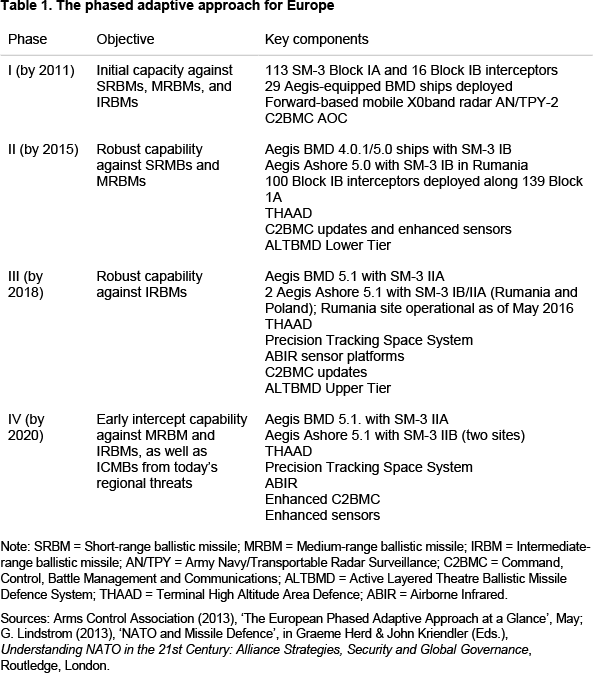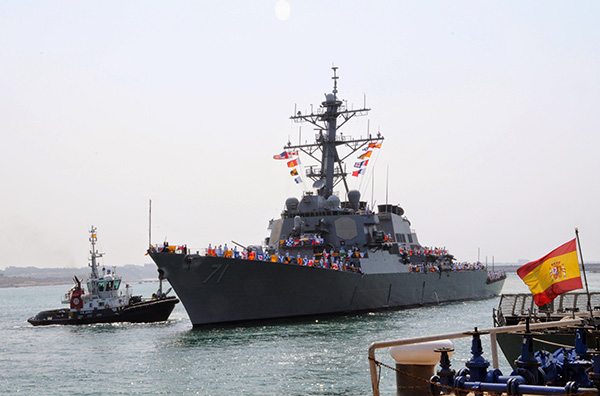Theme
Missile defence in Europe is evolving and maturing, even if it this is occurring at the margins of public debate. At the same time, there are perceptions that the missile threat is growing, in terms of both quantities and ranges. A more sophisticated approach towards missile defence in Europe is required, specifically one that considers the system’s development across the technical, political and security domains.
Summary
The year 2017 marks the 10th anniversary of missile defence in Europe. Over the decade the system has evolved from a static model involving the US and a couple of European countries to a mobile architecture in which all NATO allies are engaged. It is currently one of the largest transatlantic projects which remain largely unknown outside expert circles. If implemented properly, it will provide the US and Europe with an insurance policy against small-scale ballistic missile threats –making it a critical security project. In addition, it should enhance options against increasingly offensive Anti-Access/Area Denial (A2/AD) capabilities on the fringes of Europe. Raising the state of debate in Europe on this topic requires a more holistic approach that considers its evolution across the technical, political and security arenas.
Analysis
Introduction
Missile defence efforts in Europe are not well known or widely debated in Europe itself. One has to go back to 2009, during the US bilateral negotiations for the emplacement of interceptors in Poland and a radar facility in the Czech Republic, to find it making front page news in Europe. The lack of visibility is counterintuitive, especially given the frosty relations between the West and Russia, in particular after Russia’s annexation of Crimea from the Ukraine in 2014. The lack of strategic debate concerning missile defence in Europe is to a large extent due to its evolution across three separate domains. These cut across technical, political, and security dimensions, with developments in each area moving at different speeds and not always in a mutually reinforcing manner. Gauging the impact and implications of missile defence in Europe thus requires a more holistic examination, especially one that goes beyond the technical milestones of the system.
The technical dimension of missile defence in Europe
Three characteristics stand out with respect to the technical evolution of missile defence in Europe. First, the specifications for the project originated with US security needs in mind. At the outset of George W. Bush’s Presidency there were growing fears of a missile threat emanating from Iran. And while the US had a rudimentary missile defence capability against North Korea through its ground-based interceptors at Fort Greely (Alaska) and at Vandenberg Air Force Base (California), the Eastern portion of the US was unprotected. As a result, a third site was deemed necessary to protect against any incoming missiles originating with an eastern trajectory. Europe was identified as the ideal staging ground for such a site, providing ample time to destroy a ballistic missile prior to it approaching the US East coast. As an additional bonus, such a site would also serve to protect most, but not all, of Europe from incoming ballistic missiles.
In 2007 the US commenced its bilateral negotiations with Poland and the Czech Republic. Just like its twin sites in the US, the system in Europe would have limited technical capabilities, aiming to halt only a very small number of ballistic missiles. The missiles would be a variant of the two-stage interceptors employed at Fort Greely and Vandenberg. Given the strong US focus on this system, Europe’s contribution to this iteration of missile defence was very limited, focusing primarily on allowing and supporting the necessary infrastructures to be built in Poland and the Czech Republic.
A second characteristic of the technical evolution of missile defence in Europe is the transition from a static to a mobile missile defence system. With the arrival of the Obama Administration, a new approach was unveiled: the European Phased Adaptive Approach (EPAA). It hinges on more capable interceptors, many of which are sea-based/mobile and adaptable to perceived threat levels. The EPAA was initially envisioned to evolve over four phases (see Table 1 below), culminating with the deployment of SM-3 Block IIB missiles after 2022. The fourth phase was cancelled in March 2013, mainly due to Congressional funding cuts and the need to boost homeland defence in the US –possibly through a missile defence site on the US East coast.1 This technical transition to a more mobile system provides more flexibility and adaptability, facilitating greater coherence between political objectives and technical capabilities.

A third technical characteristic is the growing role of NATO capabilities and those of individual NATO members –even though the US remains the largest overall contributor. To facilitate the evolution of the EPAA, it was linked with NATO members’ existing and planned missile defence capabilities. Voluntary contributions by NATO states include Spain’s permanent hosting of four Aegis BMD capable ships in Rota, Turkey’s hosting of a US BMD tracking sensor in Kürecik, the updating of Dutch frigates with SMART-L radars for enhanced early warning, and the provision of an AN/TPS-77 radar by Italy to the NATO architecture.2
In addition, the EPAA was integrated with NATO’s evolving command and control network (Active Layered Theatre Ballistic Missile Defence System or ALTBMD). Looking ahead, new technologies are likely to be incorporated into missile defence efforts in Europe, including the Medium Extended Air Defence System (MEADS –spearheaded by the US, Germany and Italy) and France’s SPIRALE early warning satellite programme. The mix of a bottom-up and top-down technical approach to missile defence will create synergies, encourage interoperability and enhance burden sharing. However, it also presents important challenges, including the need to integrate multiple architectures across space-based early warning, land and sea-based sensors, competing types of terminal area interceptors, as well as command and control systems.
The political and security dimensions of missile defence in Europe
Four key issues stand out concerning the political and security dimensions of missile defence in Europe. First, there is a traditionally low political ownership vis-à-vis missile defence in Europe. Political elites in Europe are not known to publicly debate the issue nor examine its costs and benefits. On the contrary, the few political comments relating to missile defence in Europe tend to be reactive in nature, usually in conjunction with the activation of a new component or after reaching a specific level of operational capability.
The lack of political engagement is hardly surprising. During the George W. Bush era, the issue was of a bilateral nature between the US and two European countries. The rest of Europe did not have an engagement role, including organisations such as NATO and the EU. With the development of the EPAA, the dialogue has shifted to NATO missile defence capabilities, effectively making it a NATO-linked dossier. In addition, with Europe facing pressing problems such as economic fragility, a massive migratory influx, a spike in radicalisation and terrorist activity on the continent, there is little incentive to politically engage in missile defence issues.
Unfortunately, this lack of public debate also hinders strategic reflection at the European level, including the ability to form a consistent policy position towards missile defence as well as raising awareness across domestic populations. It also means Europe is unable to effectively plug into US-Russian disagreements on missile defence in Europe, including possible counter-measures taken by Russia.
Second, political positioning towards missile defence in Europe tends to trump technical advances. The demise of the initial Bush-era plan for missile defence in Europe was in part due to political roadblocks, many of which arose due to negative public opinion in Poland and the Czech Republic. Moreover, the systems’ inability to protect a large swath in the South-Eastern part of Europe, impacting countries such as Bulgaria, Greece, Rumania and Turkey, raised questions over the solidarity/protective coverage provided by the system. Even the issue of possible debris arising from the destruction of a missile over European territory, while technically suggested to be extremely low probability, surfaced as a security concern.
Exacerbating this issue are diverging views among European leaders concerning the nature of the missile threat. Many are not convinced that Iran poses a threat that requires a missile defence shield in response, especially given the costs. Some point to the July 2015 Joint Comprehensive Plan of Action between the E3/EU+3 and Iran as an additional factor diminishing tensions between the West and Iran. It is telling that NATO as a matter of policy does not cite Iran in conjunction to missile defence discussions.3
A similar situation arises given varying perceptions of Russia. In Poland, for example, concerns were raised when the 4th phase of the EPAA was put on hold. In response, the Polish authorities announced they would spend €33.6 billion over the next decade to set up their own missile shield (eg, by buying multiple batteries of US Patriot systems) and upgrade its armed forces.4 Initiatives such as these have implications for the evolution, both technical and political, of missile defence in Europe.
Further complicating the missile threat picture are developments in the A2/AD arena –including in the vicinity of Europe. While Anti-Access/Area Denial is frequently considered a defensive mechanism hinging on capabilities such as advanced air defence systems, short range ballistic missiles, precision-guided munitions and cruise missiles, A2/AD can to some degree take on offensive forms. An example might be the deployment of tactical short-range ballistic missiles closer to the European continent.
While missile defence is not an ideal tool against several A2/AD capabilities such as cruise missiles (given their low flying signature, they are more difficult to detect and track), it can play a role against short range ballistic missiles, especially during the terminal stage. As the A2/AD challenge grows, so will the pressure on theatre missile capabilities that are adaptable, especially systems that can protect deployed military personnel and associated military platforms such as vessels. As a result, mobile and multi-purpose capabilities such as the Arleigh Burke class destroyers (eg, those stationed in Rota, Spain) are likely to remain high in demand –even if the Iranian missile threat is perceived to decrease or follow a non-linear path.
Third, governance issues are increasingly coming to the political forefront. The issue was recently visible in the run-up to the NATO Warsaw Summit in early July 2016, when France signalled its reservation concerning NATO’s ability to confirm the achievement of an initial operating capability (IOC). At stake was whether the command and control system was still in US hands or under Alliance control. According to a French official quoted by the Wall Street Journal, ‘It is not just a technical question, there is a political aspect… If it is [a] NATO system, NATO takes the responsibility if you shoot down the missile. NATO takes responsibility if you miss’.5 In the ensuing July 2016 NATO Warsaw Summit, it was declared that the Alliance achieved a NATO BMD Initial Operational Capability, putting a temporary end to such discussions. Probably in response to the governance discussions prior to the summit, the declaration states that ‘full political control by Allies is essential and will be ensured over the BMD capability. We will continue to deepen political oversight of NATO BMD as the capability develops’.6 It is likely that this issue will continue to resurface at the political level as missile defence infrastructures evolve.
Lastly, there are still divergent views on whether or not missile defence in Europe results in a more secure or more vulnerable continent. Those who argue that security levels may not increase point to: (1) Russia’s growing assertiveness in relation to EPAA developments; (2) how it may undermine confidence building measures such as de-alerting, de-targeting and other indicators surrounding the operational status of nuclear weapons; and (3) lead to increased vulnerabilities through other systems such as increased efforts by some to develop evolving hypersonic glide vehicles/hypersonic missiles.
On the other side are those who argue that missile defence is increasingly a proved technology that effectively counters a growing ballistic missile threat. In support of such arguments is new data from the US Missile Defence Agency which indicates that seven out of eight interceptor tests spanning ground-based interceptors, SM-2, SM-3, SM-6 and THAAD, since 2015 were successful.7 However, these tests are always carried out under ‘controlled’ conditions, resulting in a limited understanding of how well such interceptors would do when facing missiles with advanced decoys or other countermeasures.
Conclusion
Missile defence in Europe will continue to evolve, even while remaining largely unknown outside the NATO or expert community. The evolution will be sustained by three factors: (1) the political commitment to fulfil the EPAA roadmap in conjunction with NATO ballistic missile defence efforts; (2) the security need to have an insurance policy in Europe against low probability/high impact events in the form of missile threats; and (3) the technical need for a system that may eventually need to ‘plug and play’ with other regional missile defence systems under development.
Given the extensive timeframe and substantial resource allocation required to achieve effective missile defence, European policymakers still have ample time to examine the costs and benefits associated with missile defence. To do so effectively, taking a holistic view that considers the technical, political and security dimensions associated with missile defence, including possible unintended consequences, is the right way forward.
Gustav Lindstrom
Head of the Emerging Security Challenges Programme at the Geneva Centre for Security Policy (GCSP)
1 A more detailed explanation surrounding the cancellation of the EPAA fourth phase.
2 For more information, see NATO factsheets on ballistic missile defence.
3 Steven Pifer (2012), ‘Missile Defense in Europe: Cooperation or Contention?’, Brookings Report, 8/V/2012.
4 ‘Poland Guarantees Funds for Missile Shield’, Agence France-Presse, 12/IV/2013.
5 Julian Barnes & Robert Wall (2016), ‘US, France Differ Over Readiness of NATO Missile-Defense Shield’, The Wall Street Journal, 18/V/2016.
6 Warsaw Summit Communiqué, issued by the Heads of State and Government participating in the meeting of the North Atlantic Council in Warsaw 8-9/VII/2016.
7 For more information see Ballistic Missile Defense Intercept Flight Test Record.



